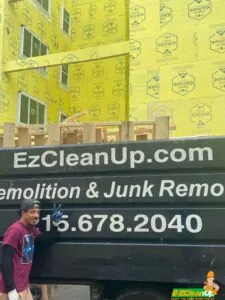Switching to a tankless water heater is a great way to boost energy efficiency and free up space. But before you enjoy the benefits, there’s one important step—removing the old unit. In this guide, learn why junk removal is key to making your tankless upgrade smooth, safe, and stress-free.
If you’re interested in why junk removal is key to tankless upgrade when removing your water heater, please continue reading.
#1 Why You Should Remove Your Old Water Heater Before Going Tankless
Switching to a tankless water heater is a smart way to save space and lower your energy bills. But before you enjoy those benefits, there’s an important step to think about—getting rid of your old water heater.
Many homeowners wonder if they really need to remove it. And the answer is yes, and hiring a junk removal service can make the process much easier.
Next, we’ll explain why taking out your old water heater is an important part of upgrading to a tankless system. We’ll also talk about how junk removal helps speed things up and make your home upgrade smoother.
So, if you’re worried about the tankless water heater installation cost, we’ll cover how removal fits into the overall price, so you know what to expect.
#2 Why You Should Remove Your Old Water Heater
When considering a tankless water heater upgrade, the first thing you may think of is getting rid of your traditional tank-style water heater. Here’s why it’s a good idea:
Save Space by Removing the Old Tank
Old water heaters are big and can take up a lot of room in basements, garages, or utility areas. So, tankless water heaters are much smaller and can be mounted on the wall.
And removing your old unit gives you more space for storage or other uses, which can make your home feel less crowded.
Cut Energy Costs with a Tankless System
Tankless water heaters use less energy because they only heat water when you need it. Unlike old water heaters, they don’t keep a big tank of water hot all day.
This means you’ll have lower energy bills over time. But to enjoy these savings, you need to remove the old unit first.
Save on Repairs and Maintenance
Old water heaters, especially those over 10 years old, can need expensive repairs. They’re also more likely to break down, leak, or waste energy.
Therefore, switching to a new tankless water heater helps you avoid costly repairs. And gives you the peace of mind that your system will work reliably.
Reduce Safety Risks
Old water heaters can be dangerous. As they age, the tank may rust, which can cause leaks or even breaks that can damage your home.
This happens more quickly in areas with hard water. And switching to a tankless system helps eliminate these risks.
#3 Why Junk Removal Is Key for Your Tankless Upgrade
Now that we’ve covered why removing your old water heater is important, let’s look at why junk removal plays a key role. Junk removal services can make upgrading to a tankless water heater easier, and here’s how:
1. Proper Disposal
Old water heaters are bulky and heavy, which makes them hard to get rid of. Most local waste services won’t pick up large appliances or hazardous materials like the chemicals in old heaters.
Junk removal services are trained to handle these items safely, which makes sure they’re disposed of properly. And some even offer recycling options to help protect the environment.
2. Streamlined Installation Process
Installing a tankless water heater requires removing the old unit and making space for the new one. So, hiring a junk removal service makes sure the area is clear and ready for installation.
This saves you time and effort, which allows the professionals to work without delays. It also makes sure that there’s no debris or obstacles in the way to make the installation smoother.
3. Minimized Mess and Damage
Removing a large water heater can cause a mess, with water leaks, dust, and debris often being part of the process. Junk removal experts know how to manage these issues, which can leave your space clean and undamaged.
They also make sure no harmful materials, like rust or mineral deposits, are left behind, especially in older systems.
4. Time-Saving Convenience
Removing an old water heater can take a lot of time, especially if you have to handle it on your own.
Junk removal services save you time by doing all the heavy lifting and hauling. So, this lets you focus on the more important parts of your upgrade, like installing the new tankless system.
#4 The Installation Process of a Tankless Water Heater
Once your old water heater is out of the way, the installation process of a tankless water heater typically goes as follows:
- Preparation – The installation team will first check the area where the tankless water heater will go. They’ll make sure the plumbing and electrical systems are ready for the new unit. If changes are needed, like adding a new electrical circuit, they’ll take care of it.
- Installation – Next, the team will mount the tankless water heater on the wall. They’ll connect the water supply and wire it to your home’s electrical system. They’ll also hook it up to your gas or electricity, depending on your chosen model.
- Testing and Calibration – Once everything is connected, the technician will test the system. They’ll check for leaks, adjust the water temperature, and make sure everything is working as it should.
- Final Inspection – After installation, a final inspection makes sure that everything is running smoothly. This is a good time to check water pressure, heating efficiency, and ask any questions about maintenance or troubleshooting.
#5 The Costs of Tankless Water Heater Installation
Upgrading to a tankless water heater can save you money in the long run, but it’s important to know the upfront costs. The price of installation depends on factors like the type of system, how complex the installation is, and any needed upgrades to your plumbing or electrical systems.
While tankless units are often more expensive than traditional water heaters, they save money over time with better energy efficiency and lower maintenance costs. If you’re concerned about the initial cost, ask your plumber about financing options or energy rebates that can help lower the price.
#6 FAQs
Can I install a tankless water heater without removing my old unit?
It’s not recommended. The old water heater needs to be removed to make space for the tankless unit. Additionally, keeping an old, outdated system in place could interfere with the proper installation of the new system.
How much space does a tankless water heater save?
Tankless water heaters are much smaller than traditional water heaters. They can be mounted on a wall, which can free up valuable space in areas like basements, garages, or utility rooms.
How long does it take to install a tankless water heater?
The installation typically takes between 4 to 8 hours, depending on the complexity of the setup. This includes removing the old water heater, preparing the area, and installing the new system.
#7 The Bottom Line – Why Removing Your Old Water Heater is Key to a Successful Tankless Upgrade
When upgrading to a tankless water heater, removing your old unit is an important step. As it clears up space and gets your home ready for the new, energy-efficient system.
Junk removal can help by safely disposing of the old water heater and preparing the area for installation.
By hiring professionals who handle both junk removal and tankless water heater installation, you guarantee a smooth upgrade and make the most of your new system. Whether replacing an old heater or upgrading for efficiency, the time and money you invest now will save you in the long run.













